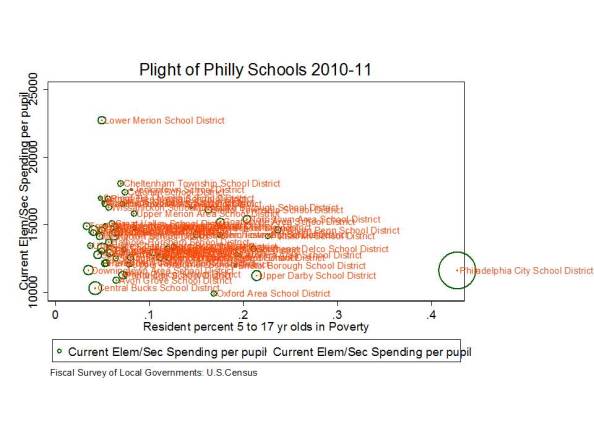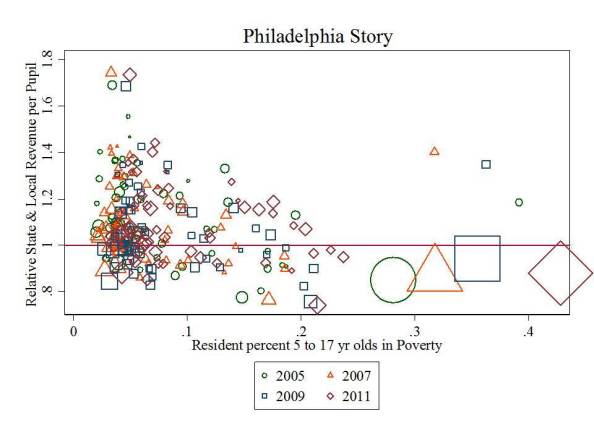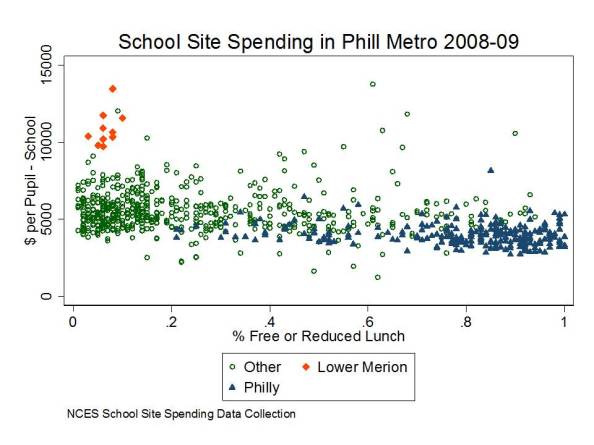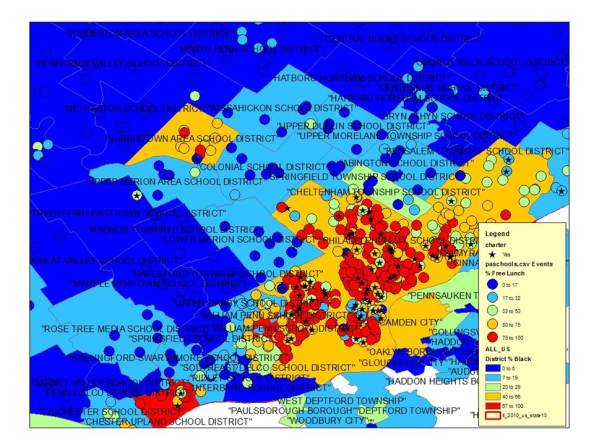School Finance 101: Debunking Reformy “Messaging”: A Philadelphia Story
Let’s take another trip back to Philadelphia for the day, because the reformy conversation around Philadelphia is just so darn illustrative of how reformy thinking works. Here’s a synopsis of the reformy approach to pushing pre-established, fact free, ideological reforms:
- Step 1: Create a story line
- Step 2: Find a poster child (school district, city, etc.)
- Step 3: Conjure some reformy buzz phrases (“failed urban district” & “sector agnosticism”)
- Step 4: Repeat, over and over and over again… with complete disregard for facts or evidence to the contrary
Nowhere is this thinking more evident than in recent Twitter activity of Andy Smarick. Let’s take a look at a few recent tweets. First, the broad crisis oriented storyline- the monolithic “urban school district” is a massive freakin’ failure. They all stink. It’s their own fault (let’s ignore urban planning and development, white flight, state school finance systems & tax policy, and the like). Crappy management – high paid bureaucrats in charge, overpaid, lazy teachers waiting out their time to collect huge pensions and bankrupt the city… that’s how it all works.
And of course, don’t forget that year, after year after year… all we’ve ever done is throw more and more money at these bureaucrats and teachers… and all they’ve done is pocket it and waste it… and really not give a crap about the kids. Enter Smarick’s seemingly favorite poster child district – Philadelphia.
Add to that some great certainty of knowledge about the city:
Certainty is really important in reformyland… especially if you have all of your facts completely wrong! Especially if nothing in your story line actually matches up with reality. If that’s the case, be wrong loudly and repeatedly. Don’t back down. Rule #1 in the reformy story line.
[Now, one might accept Smarick's claim that Philly's total state aid likely does exceed all other districts in the state. But that comparison reveals a whole new level of ignorance. Philly is actually larger than most PA districts? Yep... & Philly's local revenue raising capacity (while better than some) is pretty weak. Overall, per pupil state and local resources in Philly (the right comparison) are pretty darn low as discussed below.]
So, let’s recap here. The story line is that urban school districts are an evil monolithic blob that eats up poor, disadvantaged kids. They all suck.
That is the status quo! No doubt about it.
They must be dismantled. The must be closed and charterized. They can’t be fixed. It’s that simple. It all just requires a rethinking… a relinquishing (read “submission) of control to those necessarily better charter operators. Mind you, we only want charter operators who are among the “above average” group. ‘Cuz we all know that while charter schools, on average, are average, the really good ones are above average!
Arguably, the most important step in the reformy story line development above is selection of the poster child, and then perhaps validating that the poster child is somehow representative of others – you know… so that the whole idea is scalable.
So, what would be required here, to validate that we have the right poster child?
Well, you’d probably want to find a district that has actually seen some infusions of funding over time, for naught.
You’d probably want to find a district that hasn’t already been adopting the strategies you propose as the solution (for over 10 years).
That is, you ought to vet your poster child… at least at some level.
But alas, this would require the very slightest effort to look at some numbers… gosh no… not math… not data… and read some real research… rather than think tank goo from the reformy echo-chamber.
So, what is the status quo in Philly?
For the past 10+ years, Philly has seen rapid expansion of charter schooling, and Philadelphia charter schools have generally not topped the list of stellar performers.
For the past 10+ years, Philly has tried outsourcing management of large numbers of schools to private management companies, including Edison, where the research conducted on these reforms seemed to suggest that resources, not management type, mattered more.
Oh yeah… and they’ve even tried “weighted student funding,” an oft-relied on reformy distraction from real equity concerns. (and one that doesn’t work so well if you simply don’t have the money to redistribute).
For the past few decades, Philly public schools have been systematically financial deprived as a function of one the nation’s most inequitable state school finance systems. To review:
- Pennsylvania has among the least equitable state school finance systems in the country, and Philly bears the brunt of that system.
- Pennsylvania’s school finance system is actually designed in ways that divert needed funding away from higher need districts like Philadelphia.
- And Pennsylvania’s school finance system has created numerous perverse incentives regarding charter school funding, also to Philly’s disadvantage. (see here also)
The Philly area remains among the most racially and economically segregated areas in the nation.
So wait a second… the actual status quo in Philly is reformyness itself?… not throwing money at the problem. For more than 10 years, Philly has been an experiment in resourceless (but for some funding applied through the privatization venture in the early 2000s) reformyness. So, if Philly is the poster child here, then perhaps the story line has some pretty significant flaws.
But don’t let the facts get in the way!
What do the Numbers Look Like for Philly?
First, here is the state and local revenue per pupil for Pennsylvania school districts in the Philly metro area with respect to poverty.
Figure 1
Second, here’s the current operating expenditure per pupil for Pennsylvania school districts in the Philly metro area with respect to poverty.
Figure 2
As I’ve noted, over and over and over again… no-one’s been throwin’ money at Philly… not now, not two years ago… not five years ago… not further back than that!
Figure 3
And you know what, it’s not because Philly is just throwing all of their money into their own low poverty schools. The disparity that exists at the district level passes right along to the school level.
So forcing Philly to adopt a decentralized weighted student funding formula in order to fix their own equity problems really isn’t a major solution either! Wait… already done that!
Figure 4
Actually, the only one doin’ money throwin’ here is arguably Lower Merion School District. But hey, Lower Merion must be pretty far away geographically. Perhaps they are in a remote, rural area, where they need to spend more due to population sparsity or economies of scale. Or perhaps not. Here’s a map showing the locations of schools (by % Free Lunch) and districts by % Black in the Philly area.
Figure 5
So wait, Lower Merion is just a wealthy white suburb… right next door? And by the way… to clarify as I have on many previous posts… the big disparities here are between, not within districts. Kids are segregated largely between, not within districts. We have rich districts, white districts, poor districts, black districts. We have poor, minority schools in poor minority districts and richer whiter schools in richer whiter districts. It is actually that simple… almost. And in Pennsylvania, poorer minority schools are sadly lacking in state support.
Now, let’s take a quick look at the patterns of “chartering” that have occurred by 2011. Charters have a little star on them. Sorry, no gold star. I’m not in the business of handing those out. First of all, we see that charters only exist in districts with more black students and more low income schools. Charters aren’t flourishing in the Philly ‘burbs, like Lower Merion! (that’s because they must have “great” schools!?).
As I’ve noted on previous posts, this means that larger shares of low income and minority students (and their teachers) are potentially subjected to greater deprivation of constitutional and statutory protections – unless states step in to clean up their charter laws.
Now let’s look a little closer. As if the Philly area wasn’t already sufficiently segregated, what we see here is that within Philly, several charter schools seem to be serving relatively low shares of low income kids (qualifying for free lunch) when compared with surrounding district schools. Most district schools are bright red here… while several charters… well… are not.
So, what’s happening with charter expansion in Philly is an increase to socioeconomic segregation in some areas… but little or no attempts to correct resource disparities.
Figure 6
Wow… seems like that reformy story line has a few cracks in it, eh?
But hey, don’t let the facts get in the way.
Why “chartering” & “sector agnosticism” isn’t the solution for Philly
Let’s start by reiterating the point that too much funding, classic bureaucratic waste, not enough choice/charters and not enough privatization ARE NOT the problem in Philly.
So, here’s a quick summary of why chartering and “sector agnosticism” aren’t the simple, logical solution for Philadelphia as the post child for the failed urban school district.
- Chartering seems to simply be leading to greater segregation of the already segregated, leaving behind even higher concentrations of more disadvantaged kids in district schools
- Pennsylvania charter schools don’t seem to have a particularly strong record of academic performance, despite their propensity to sort.
- Chartering, as has been practiced thus far, leads to substantive deprivation of student and employee constitutional and statutory protections. Worse, when chartering is adopted as the solution solely for poor, minority contexts, then it is poor and minority students who disproportionately forgo these rights, most of the time unknowingly.
- Chartering, as has been practiced thus far, has reduced fiscal and governance transparency, as charter managers/operators increasingly shield their records under private governance (contract information, financial dealings, real estate holdings/dealings, etc.).
- Even if we accept a “sector agnostic” perspective – acknowledging the transparency and rights concerns – success requires resources. Equitable and adequate funding is a prerequisite condition for improving conditions in Philadelphia.
Like I said in a previous post. The ridiculous must stop. The buzz phrase reformyism, shallow logic, and lack of disciplined inquiry must be replaced with more thoughtful and measured analysis, thinking and ultimately policy development.
As far as Philadelphia is concerned, real reform must begin with resources!
This blog post has been shared by permission from the author.
Readers wishing to comment on the content are encouraged to do so via the link to the original post.
Find the original post here:
The views expressed by the blogger are not necessarily those of NEPC.






